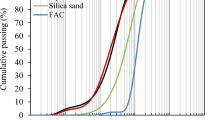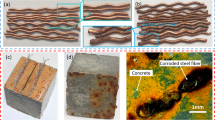Abstract
This study investigates the combined effect of the strain rate and temperature on the compressive properties of hybrid fiber ultra high toughness cementitious composites (UHTCCs) using a Split Hopkinson pressure bar. Specimens were first heated to different exposure temperatures, e.g. ambient temperature, 200, 400, 500, 600 and 800 °C, and subsequently, cooled to ambient temperature. Thereafter, the specimens were tested at four different strain rates. The test results show that the dynamic compressive strength of the UHTCC is enhanced at a temperature of 200 °C, and subsequently, decreases with the increase in exposure temperature. The strain rate sensitivity of UHTCC is largely enhanced with the increase in exposure temperature. The possible mechanism of this phenomenon was discussed based on the high-speed photography of the crack propagation process on the surface of the specimens and microscopic observation of fibers condition on their fracture surfaces. Moreover, an empirical relationship is established to express the dynamic strength enhancement of fire-damaged UHTCC as a function of strain rate.










Similar content being viewed by others
References
Li V (2007) Engineered cementitious composites (ECCs)–material, structural, and durability performance. CRC Press, Boca Raton
Li V, Leung C (1992) Steady-state and multiple cracking of short random fiber composites. J Eng Mech 118(11):2246–2264
Rokugo K, Kanda T, Yokota H, Sakata N (2009) Applications and recommendations of high performance fiber reinforced cement composites with multiple fine cracking (HPFRCC) in Japan. Mater Struct 42(9):1197–1208
Li H, Xu S, Leung CKY (2009) Tensile and flexural properties of ultra high toughness cementitious composite. J Wuhan Univ Technol 4(24):677–683
Li H, Xu S (2010) Research on flexural properties and flexural toughness evaluation method of ultra high toughness cementitious composites. China Civ Eng J 43(3):32–39
Xu S, Cai X (2010) Experimental study and theoretical models on compressive properties of ultrahigh toughness cementitious composites. J Mater Civ Eng 22(10):1067–1077
Chen Z, Yang Y, Yao Y (2013) Quasi-static and dynamic compressive mechanical properties of engineered cementitious composite incorporating ground granulated blast furnace slag. Mater Des 44:500–508
Li Q, Zhao X, Xu S, Gao X (2016) Influence of steel fiber on dynamic compressive behavior of hybrid fiber ultra high toughness cementitious composites at different strain rates. Constr Build Mater 125:490–500
Wang S, Hoang TNL, Leong HP, Quek ST, Zhang M (2017) Effect of high strain rate on compressive behavior of strain-hardening cement composite in comparison to that of ordinary fiber-reinforced concrete. Constr Build Mater 136:31–643
Maalej M, Quek ST, Zhang J (2005) Behavior of hybrid-fiber engineered cementitious composites subjected to dynamic tensile loading and projectile impact. J Mater Civ Eng 17(2):143–152
Li H, Xu S (2016) Rate dependence of ultra high toughness cementitious composite under direct tension. J Zhejiang Univ Sci 17(6):417–426
Mechtcherine V, Millon O, Butler M, Thoma K (2011) Mechanical behaviour of strain hardening cement-based composites under impact loading. Cem Concrete Compos 33(1):1–11
Soe KT, Zhang YX, Zhang LC (2013) Impact resistance of hybrid-fiber engineered cementitious composite panels. Compos Struct 104:320–330
Zhang J, Maalej M, Quek ST (2007) Performance of hybrid-fiber ECC blast/shelter panels subjected to drop weight impact. J Mater Civ Eng 19(10):855–863
Yang E (2007) Designing added functions in engineered cementitious composites. PhD Dissertation, Department of Civil and Environmental Engineering. PhD Dissertation, University of Michigan
Fib - fédération internationale du béton, International Federation for Structural Concrete (2012) fib Bulletin No. 65, Fib Model Code 2010, Final draft. Lausanne, Switzerland, pp 160–162
Huo J, He Y, Xiao L, Chen B (2013) Experimental study on dynamic behaviours of concrete after exposure to high temperatures up to 700 °C. Mater Struct 46(1–2):255–265
Xiao J, Li Z, Xie Q, Shen L (2016) Effect of strain rate on compressive behaviour of high-strength concrete after exposure to elevated temperatures. Fire Saf J 83:25–37
Sahmaran M, Lachemi M, Li VC (2010) Assessing mechanical properties and microstructure of fire-damaged engineered cementitious composites. ACI Mater J 107(3):297–304
Sahmaran M, Ozbay E, Yucel HE, Lachemi M, Li VC (2011) Effect of fly ash and PVA fiber on microstructural damage and residual properties of engineered cementitious composites exposed to high temperatures. J Mater Civ Eng 23(12):1735–1745
Li Q, Gao X, Xu S, Peng Y, Fu Y (2016) Microstructure and mechanical properties of high-toughness fiber-reinforced cementitious composites after exposure to elevated temperatures. J Mater Civ Eng 28(11):04016132
Yu J, Lin J, Zhang Z, Li VC (2015) Mechanical performance of ECC with high-volume fly ash after sub-elevated temperatures. Constr Build Mater 99:82–89
He Y, Huo J, Xiao Y (2011) Experimental study on dynamic behavior of concrete at elevated temperatures. Adv Sci Lett 4(3):1128–1131
Li Z, Xu J, Bai E (2012) Static and dynamic mechanical properties of concrete after high temperature exposure. Mater Sci Eng A Struct 544:27–32
Chen L, Fang Q, Jiang X, Ruan Z, Hong J (2015) Combined effects of high temperature and high strain rate on normal weight concrete. Int J Impact Eng 86:40–56
Ren W, Xu J, Su H (2016) Dynamic compressive behavior of basalt fiber reinforced concrete after exposure to elevated temperatures. Fire Mater 40(5):738–755
Mechtcherine V, Silva FDA, Mueller S, Jun P, Toledo Filho RD (2012) Coupled strain rate and temperature effects on the tensile behavior of strain-hardening cement-based composites (SHCC) with PVA fibers. Cem Concrete Res 42(11):1417–1427
Ahmed SFU, Maalej M, Paramasivam P (2007) Flexural responses of hybrid steel-polyethylene fiber reinforced cement composites containing high volume fly ash. Constr Build Mater 21(5):1088–1097
Maalej M, Quek ST, Ahmed SFU, Zhang J, Lin VWJ, Leong KS (2012) Review of potential structural applications of hybrid fiber Engineered cementitious composites. Constr Build Mater 36:216–227
Li Q, Gao X, Xu S (2016) Multiple effects of nano-SiO2 and hybrid fibers on properties of high toughness fiber reinforced cementitious composites with high-volume fly ash. Cem Concrete Compos 72:201–212
Soe KT, Zhang YX, Zhang LC (2013) Material properties of a new hybrid fibre-reinforced engineered cementitious composite. Constr Build Mater 43:399–407
Xiao J, Konig G (2004) Study on concrete at high temperature in China—an overview. Fire Saf J 39(1):89–103
Kim Y, Lee T, Kim G (2013) An experimental study on the residual mechanical properties of fiber reinforced concrete with high temperature and load. Mater Struct 46(4):607–620
Han LH, Zheng YQ, Tao Z (2009) Fire performance of steel-reinforced concrete beam-column joints. Mag Concrete Res 61(7):499–518
GB/T 34218-2017 (2017) Refractory products-determination of compressive strength at elevated temperature. China National Standard, Beijing
Su H, Xu J, Ren W (2014) Experimental study on the dynamic compressive mechanical properties of concrete at elevated temperature. Mater Des 56:579–588
Fan L, Wu Z, Wan Z, Gao J (2017) Experimental investigation of thermal effects on dynamic behavior of granite. Appl Therm Eng 125:94–103
Fan L, Gao J, Wu Z, Yang S, Ma G (2018) An investigation of thermal effects on micro-properties of granite by X-ray ct technique. Appl Therm Eng 140:505–519
Colombo M, Marco D, Felicetti R (2015) SFRC exposed to high temperature: hot vs. residual characterization for thin walled elements. Cem Concrete Compos 58:81–94
Zhou X, Hao H (2008) Modelling of compressive behaviour of concrete-like materials at high strain rate. Int J Solids Struct 45(17):4648–4661
Kolsky H (1949) An investigation of the mechanical properties of materials at very high rates of loading. Proc Phys Soc B 62(11):676–700
Mindess S, Young JF, Darwin D (2003) Concrete. Pearson Education Inc., Upper Saddle River
Wang S, Zhang M, Quek ST (2011) Effect of specimen size on static strength and dynamic increase factor of high-strength concrete from SHPB test. J Test Eval 39(5):898–907
Georgali B, Tsakiridis PE (2005) Microstructure of fire-damaged concrete. A case study. Cem Concrete Compos 27(2):255–259
Chang Y, Chen Y, Sheu M, Yao G (2006) Residual stress–strain relationship for concrete after exposure to high temperatures. Cem Concrete Res 36(10):1999–2005
Xiao J (2015) Fire safety design principle of high performance cencrete structures. Science Press, Beijing
Zhang Z, Xu J, Su H, Liu Z (2015) Dynamic strength property of concrete at exposure to elevated temperature. Bull Chin Ceram Soc 34(2):501–505
Yu Q (2007) Experimental study on SHPB impact behaviors of plain concrete at elevated temperatures. M.S Dissertation, University of Hunan
Su H, Xu J, Ren W (2016) Mechanical properties of geopolymer concrete exposed to dynamic compression under elevated temperatures. Ceram Int 42(3):3888–3898
Huo J, Zheng Q, Chen B, Xiao Y (2009) Tests on impact behaviour of micro-concrete-filled steel tubes at elevated temperatures up to 400 °C. Mater Struct 42(10):1325–1334
Rossi P, Vanmier J, Toutlemonde F, Lemaou F, Boulay C (1994) Effect of loading rate on the strength of concrete subjected to uniaxial tension. Mater Struct 27(169):260–264
Rossi P, Vanmier J, Boulay C, Lemaou F (1992) The dynamic behavior of concrete—influence of free-water. Mater Struct 25(153):509–514
Eibl J, Curbach M (1989) An attempt to explain strength increase due to high loading rates. Nucl Eng Des 112:45–50
Bischoff P, Perry S (1991) Compressive behavior of concrete at high-strain rates. Mater Struct 24(144):425–450
Rossi P, Toutlemonde E (1996) Effect of loading rate on the tensile behaviour of concrete: description of the physical mechanisms. Mater Struct 29(186):116–118
Lambert DE, Ross CA (2000) Strain rate effects on dynamic fracture and strength. Int J Impact Eng 24(10):985–998
Qin C, Zhang C (2011) Numerical study of dynamic behavior of concrete by meso-scale particle element modeling. Int J Impact Eng 38(12):1011–1021
Reinhardt H, Weerheijm J (1991) Tensile fracture of concrete at high loading rates taking account of inertia and crack velocity effects. Int J Fract 51(1):31–42
Hassan A, Jones S, Mahmud G (2012) Experimental test methods to determine the uniaxial tensile and compressive behaviour of ultra high performance fibre reinforced concrete (UHPFRC). Constr Build Mater 37:874–882
Nataraja M, Dhang N, Gupta A (1999) Stress–strain curves for steel-fiber reinforced concrete under compression. Cem Concrete Compos 21(5–6):383–390
Acknowledgements
This study was funded by the National Natural Science Foundation of China under Grant Nos. 51622811, 51678522 and 51908505.
Author information
Authors and Affiliations
Corresponding author
Ethics declarations
Conflict of interest
The authors declare that they have no conflict of interest.
Additional information
Publisher's Note
Springer Nature remains neutral with regard to jurisdictional claims in published maps and institutional affiliations.
Electronic supplementary material
Below is the link to the electronic supplementary material.
Rights and permissions
About this article
Cite this article
Zhao, X., Xu, S., Li, Q. et al. Coupled effects of high temperature and strain rate on compressive properties of hybrid fiber UHTCC. Mater Struct 52, 92 (2019). https://doi.org/10.1617/s11527-019-1391-4
Received:
Accepted:
Published:
DOI: https://doi.org/10.1617/s11527-019-1391-4




